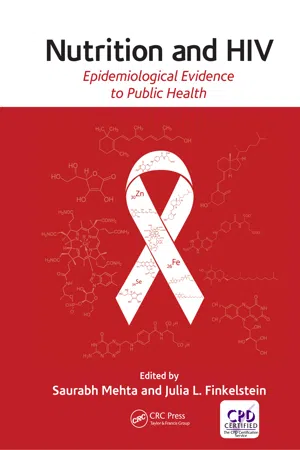![]()
Contents
List of Figures
List of Tables
Foreword
Preface
About the Editors
About the Contributors
Abbreviations
Chapter 1 Human Immunodeficiency Virus and Vitamin A
Samantha L. Huey and Saurabh Mehta
Chapter 2 B-Vitamins and HIV/AIDS
Alexander J. Layden and Julia L. Finkelstein
Chapter 3 Iron and HIV/AIDS
Nabila R. Khondakar and Julia L. Finkelstein
Chapter 4 Vitamin D and HIV
Elaine A. Yu and Saurabh Mehta
Chapter 5 Antioxidants and HIV/AIDS: Zinc, Selenium, and Vitamins C and E
Amanda L. Wilkinson, Samantha L. Huey, and Saurabh Mehta
Chapter 6 Micronutrients and Perinatal Outcomes in HIV-Infected Pregnant Women
Julia L. Finkelstein and Saurabh Mehta
Chapter 7 HIV and Infant Feeding
Ameena Goga and Anna Coutsoudis
Chapter 8 Micronutrients and HIV in Pediatric Populations
Julia L. Finkelstein, Haritha Aribindi, Heather S. Herman, and Saurabh Mehta
Chapter 9 Macronutrient Supplementation to HIV and TB Patients during Treatment
Henrik Friis, Mette Frahm Olsen, and Suzanne Filteau
Index
![]()
Figure 1.1 Study selection
Figure 2.1 Diagrammatic representation of the search strategy used to identify and select studies for inclusion in the review.
Figure 3.1 Search strategy (search date closed November 18, 2015; last updated July 11, 2016). Randomized controlled trials (RCTs) are RCTs with intervention as iron and RCTs with intervention as HAART or HAART/ iron
Figure 4.1 Study selection
Figure 5.1 Study selection
Figure 6.1 Study selection
Figure 7.1 Example of an algorithm used to apply the AFASS Criteria in South Africa
Figure 7.2 Dilemma faced by public health.
Figure 8.1 Study selection
Figure 9.1 Weight changes over a 12-month period, according to sex of patients and place of treatment
![]()
List of Tables
Table 1.1 Laboratory and Animal Studies
Table 1.2 Observational Studies
Table 1.3 Randomized Controlled Trials
Table 1.4 Vitamin A and ART/HAART
Table 2.1 Summary of Multivitamin Trials
Table 2.2 Randomized Trials of Multiple Micronutrient Interventions
Table 2.3 Randomized Trials of Single Micronutrient Interventions
Table 3.1 Randomized Controlled Trials
Table 3.2 Intervention Studies
Table 3.3 Cohort Studies
Table 3.4 Case-Control Studies
Table 3.5 Cross-Sectional Studies
Table 4.1 Vitamin D and HIV Disease Progression among Individuals Living with HIV
Table 4.2 Vitamin D Supplementation among Individuals Living with (or Exposed to) HIV/AIDS in Intervention Studiesa
Table 4.3 Effects of ART on Vitamin D Status among Individuals Living with HIV/AIDS in Randomized Controlled Trials
Table 5.1 Trials of Zinc Supplementation in Adults and Children with HIV Infection
Table 5.2 Trials of Selenium Supplementation in Adults and Children with HIV Infection
Table 5.3 Trials of Vitamin C and/or E Supplementation in Adults and Children with HIV Infection
Table 6.1 Randomized Trials
Table 7.1 Summary of WHO PMTCT Guidelines: 2000 to Date
Table 7.2 Estimated Timing and Risk of Mother-to-Child Human Immunodeficiency Type 1 Transmission without Antiretroviral Interventions and with Minimal Antiretroviral Prophylaxis
Table 7.3 Percentage Decline in New HIV Infections among Children from 2009 to 2015 in 20 Global Plan Priority Countries
Table 7.4 Population Attributable Fractions for Late Postnatal Transmission in Sub-Saharan Africa
Table 7.5 Immunologic Properties in Breast Milk and Infant Responses to HIV Exposure May Protect Against MTCT
Table 7.6 Breast Milk HIV Transmission When No Antiretroviral Interventions Were Available
Table 7.7 HIV Transmission through Breastfeeding with Minimal ARV Interventions
Table 7.8 HIV Transmission through Breastfeeding in the Era of Maternal or Infant ARV Prophylaxis/Treatment
Table 7.9 Immunotherapeutic (Vaccine) Trials Applicable to MTCT
Table 7.10 Support for Infant Feeding among HIV-Infected Women Based on the 2000 WHO Guidelines
Table 8.1 Micronutrient Supplementation in HIV-Infected and HIV-Exposed Children
Table 8.2 Micronutrient Supplementation in HIV-Infected and HIV-Uninfected Children
Table 8.3 Micronutrient Supplementation in HIV-Infected Children
Table 8.4 Micronutrient Supplementation in HIV-Infected Mothers and Their Children
Table 9.1 Potential General and Disease-Specific Effects of Nutritional Deficiencies
![]()
Foreword
Ron:
I thought AZT’s supposed to help me.
Dr. Vass:
The only people AZT helps are the people who sell it. (beat) It kills every cell it comes in contact with, good and bad.
Ron:
So medically speakin’, I kicked my own ass!
Dr. Vass:
(nods as he writes)
I’m prescribing a regimen of vitamins as well as the mineral zinc to build your immune system back up.
You’ll also be taking Aloe and essential fatty acids.
Dallas Buyers Club script
The above excerpt from the script for the 2013 American film Dallas Buyers Club is from a scene that touched me in both personal and professional ways. This encounter between Ron (Matthew McConaughey) and Dr. Vass (Griffin Dunne) represents a historical turning point in the role of nutrition in the management of the HIV epidemic. I have long reflected on the particular period reflected in the movie. There has been an unprecedented search to understand the impact that nutrition has on the health and wellbeing of individuals living with HIV/AIDS. The almost messianic merits of “alternative” approaches to HIV and AIDS prevention and treatment played an important role during one of the worst moments of the epidemic. We finally reached the point of acknowledging that fighting against HIV also entails dealing with lifestyle modifications. The various definitions of healthy lifestyles are vague, but equally uncertain are the nutritional recommendations regarding HIV and AIDS. Numerous research efforts have produced myriad results that appear to conflict with each other. The concept of evidence-based medicine gained visibility at about this same time. Given the existing scientific evidence and experience to date, it would be irresponsible to ignore the importance of nutrition in patient-centered care for those living with HIV.
I lived similar scenes of despair when I lost friends and family members to this disease. During my research at the Latin American Center for Sexually Transmitted Diseases in Puerto Rico, many patients poured through the clinic doors reporting allegedly efficacious nutrition interventions. Like Ron, the main character in Dallas Buyers Club, patients in many hos...
